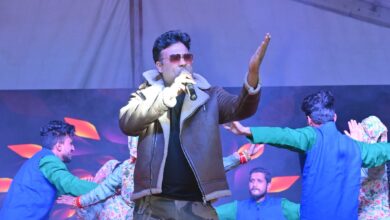Colorful Ekadashi: Shiva-Parvati coming to Kashi

There is a tradition of mourning the whole year in the family or society on the day of Rangbhari Ekadashi. That is, on this day all auspicious works are started in the bereaved families. According to folk tradition, music programs are not held in those families, drums are not played, lights are not performed, rituals like shaving etc., new clothes are not bought and many other types of auspicious work are stopped and mourned on the colorful Ekadashi. After leaving, auspicious work starts in the family.
The Ekadashi of Fee Paksha of Falgun month is called Rangbhari Ekadashi. Rangbhari means full of all kinds of colours, that is, one who is full of every colour. Colorful Ekadashi is also known as Amalaki Ekadashi. This special festival of social harmony, the arrival of Shiva to Kashi and the welcome of Parvati to Kashi, the worship of the Amla tree and the devotion of Khatu Shyam, this special festival of Rang Bhari Ekadashi is important for many reasons. Amalaki Ekadashi is not dedicated to Vishnu but to Lord Shiva. Amalaki Ekadashi, the special festival of Banaras, is celebrated six days before Holi. Rangbhari Ekadashi is celebrated in many parts of North India but it has special significance in Varanasi. After Braj, the mythological and traditional Holi of Lord Kashi is very famous. The festival of Rangbhari Gyaras is one of the most popular festivals here. This festival also marks the first welcome of Mother Parvati to her in-laws’ house.
There is a tradition of mourning the whole year in the family or society on the day of Rangbhari Ekadashi. That is, on this day all auspicious works are started in the bereaved families. According to popular belief, no auspicious work is done in the bereaved family for a whole year in the event of the death of someone in the family or any other kind of mourning. According to folk tradition, music programs are not held in those families, drums are not played, lights are not lit, shavings etc., rites are not performed, new clothes are not bought and many other auspicious works are stopped.
This time is spent recovering from grief. But after the mourning is raised on the colorful Ekadashi, auspicious work starts in the family. On this day relatives and relatives reach the place of mourning family and apply Gulal to everyone. In this way the shadow of mourning rises from the head of that bereaved family. After this, dishes and sweets start being made in the bereaved family. Auspicious and auspicious works are started in the family. It is believed that auspicious and auspicious works begin in homes only from Rangbhari Ekadashi. This day is considered good for the beginning, hence Rangbhari Ekadashi has special significance. Thus, this day of Rangbhari Ekadashi symbolizes social harmony and family love, good luck and enthusiasm.
Rangbhari Ekadashi falls between Mahashivratri and Holi. According to Shiva Purana, Lord Shiva had arrived in Kashi for the first time after his marriage with Mother Parvati, and the people of Kashi celebrated this happiness by applying Abir Gulal to each other. According to the legend, when Shiva came to Kashi for the first time with Parvati, his devotees present in the Gauna procession fiercely play the Holi of Abir, but his other gan i.e. Ghost-Pret-Aughad could not go there. On the second day, Bholenath goes to Manikarnika Ghat in Banaras, where he plays Holi with his devotees with the ashes of the pyre. Even today this tradition of Holi is alive at Manikarnika Ghat in Banaras. Here devotees are seen playing Holi with the slogan of Har Har Mahadev with its ashes in front of a burning pyre on the beat of Damru. After the aarti at the cremation ground, the Aughad sadhus play Holi with pyre ash. In the midst of all the tourists coming from abroad and country, on one side, where pyres are burning and their relatives are immersed in the ocean of sorrow, on the other hand there is fun of Holi with pyre. This diversity of traditions and way of life perhaps separates Banaras from the whole world. There is a mythological belief that Kashyam Maranam Muktih means salvation is attained by dying in Kashi. This liberation is given by Lord Shankar himself here with his tarak mantra. Everyone participates in the Holi of this cremation ground of the God of such salvation and since then in Banaras, the devotees also get permission to celebrate Holi.
It is noteworthy that even today in Kashi, on this day, grand makeup of Kashipuradhipati Devadhidev Mahadev Baba Vishwanath is done. After the early morning worship, on this auspicious occasion, movable idols of Shiva family are brought to Kashi Vishwanath temple. Then Baba Shri Kashi Vishwanath, on a tour of his Kashi region with the sound of musical instruments, goes out with his family to bless his people, devotees, devotees. Shivgana throws color abir gulal on their idols and all the people, dances and sings celebrating happiness. All the streets of Kashi are filled with joy and enthusiasm with the Rangbir played and the chants of Har Har Mahadev resonate in all directions. It is as if after this Shri Mahakal is taken to the family temple in the womb place, after adornment, abir, color, gulal etc. are offered. From this day the process of playing colors starts in Varanasi and it continues for six consecutive days. There is a festive atmosphere every day during this time. Everyone comes together to celebrate happiness and seek the blessings of Lord Shiva and Mother Parvati.
Rangbhari Ekadashi is also called Amalaki Ekadashi in Puran texts. Amalaki means Amla. It should be noted that some of the rules of protection of trees are associated with many festivals of Sanatan Dharma, the most conscious of religions. Amalaki Ekadashi is associated with the tradition of preserving a useful tree like Amla. It is believed that due to the abode of Shri Hari i.e. Shri Vishnu under the Amla tree, the Amla tree, dear to Lord Vishnu, is also worshiped on the day of Gyaras. In ancient Indian texts, Amalaki i.e. Amla has got a high place in the rivers like the Ganges and in the gods like Lord Vishnu. According to Padma Purana, when Vishnu gave birth to Brahma to create the universe, at the same time he also gave birth to the Amla tree. Amla is worshiped by Lord Vishnu in the form of Adi tree. On this day, Vishnu devotees observe a fast on Ekadashi and worship Lord Vishnu and Amla tree by facing east to attain salvation. According to religious tradition, after offering flowers, incense, lamp, naivedya etc. in the worship of Amla tree, the tree is circumambulated after performing an aarti. Donating amla fruit useful for health also increases good luck. Devotees should reverently wake up in the morning on this day, after bathing, offer water to the gooseberry tree and light a lamp. Apart from this, the Amla tree should be circumambulated nine or twenty seven times.
On this day, after bathing in the morning, after filling water in a vessel from home, taking color, abir gulal, sandalwood and Belpatra, going to the Shiv temple, first of all, apply sandalwood on the Shivling, then it is considered best to offer Bel leaves and water. After that Abir Gulal should be offered to Shiva. On the day of Rangbhari Ekadashi i.e. Amalaki Ekadashi, there is a law to worship the gooseberry tree. It is said that worshiping the gooseberry tree on this day brings good health and good fortune. Devotees should reverently wake up in the morning on this day, after bathing, offer water to the gooseberry tree and light a lamp. Apart from this, the Amla tree should be circumambulated nine or twenty seven times.
According to another belief, on the Ekadashi of Falgun Shukla month, the head of Shyam Baba appeared for the first time in Shyam Kund in Khatu village of Sikar district of Rajasthan state. Khatu Shyam is considered an incarnation of Lord Krishna. That is why on this day lakhs of Shyam devotees go to Khatu for Shyam Darshan. According to another belief, on the eleventh day of the Shukla Paksha of Falgun month, Khatu Baba was placed in a temple near the Kund. In 1720 AD, Diwan Abhay Singh got this temple rebuilt and since then till today the shine of that temple remains the same. In relation to the famous Shyam Kund in the country and abroad, it is believed that every wish of the one who takes bath in this pool is fulfilled.
This is the reason that lakhs of devotees also take a dip in Shyam Kund during the fair. It is worth mentioning that Shyam Kund is the same place where Shri Shyam’s Shaligram Deity was received. It is believed that the water of Shyam Kund is considered very holy because of its healing factor and the power to destroy sins. This fair is not only a symbol of religious unity in the society, but it also displays the strength, unity and enthusiasm in the society. Hence lakhs of devout devotees gather during the fair to offer their prayers to Shree Shyam Baba. Large contingents of devotees flock towards Khatu, chanting songs related to Shree Shyam Baba and shouting slogans while doing padyatra. This journey is also called the trail journey. In the fair, lakhs of devotees offer flag to Shree Shyam as a mark. It is believed that by offering a mark to Shree Shyam, Shyam fulfills all the wishes of the devotees. By mentioning the surnames of Shri Shyam, the devotees describe his glory and express their faith in him.





